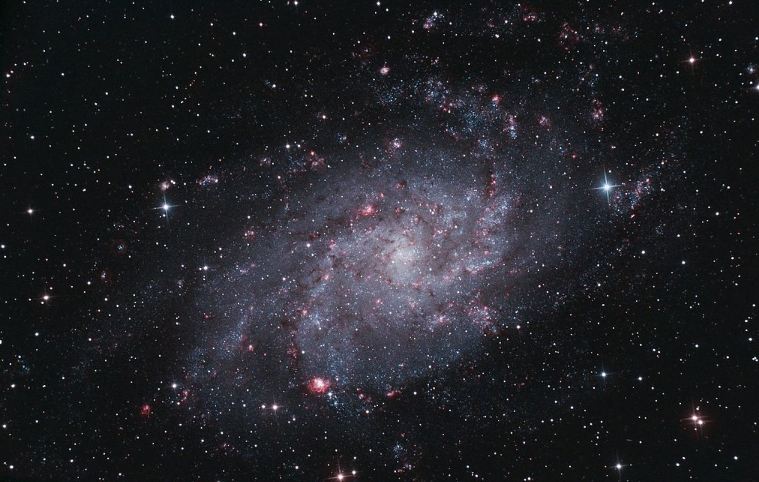The Triangulum galaxy is a spiral galaxy about 3 million light-years from Earth in the constellation Triangulum. The galaxy cataloged as Messier 33, or NGC 598, belongs to the Local Group of galaxies, including our Milky Way and the Andromeda galaxies. It is one of the smallest in the Local Group and believed to be Andromeda’s satellite or rebound into the latter due to their velocity, interactions, and proximity to one another in the night sky. Triangulum galaxy is one of the most distant permanent objects that can be viewed with the naked eye.
With a diameter of about 50,000 light-years or about one-half of our Milky Way, the galaxy is thought to contain approximately 40 billion stars. Additionally, astronomers found out evidence in 2014 that the galaxy has a clumpy stream of hydrogen gas linking with the nearby Andromeda galaxy. After a year, they could also estimate the proper motion-sideways motion on our sky’s dome.
In 2004, astronomers found evidence for a clumpy stream of hydrogen gas linking the Triangulum galaxy with the Andromeda galaxy. A year later, they were able to estimate the galaxy’s proper motion, which is sideways motion on our sky’s dome. Moreover, they discovered that the galaxy is moving towards the Andromeda galaxy. This means that over a timescale so vast we haven’t yet comprehended it, the Triangulum galaxy might orbit around the Andromeda galaxy.
Astronomers and scientists theorized that the Andromeda galaxy is moving toward the Milky Way, and there will be a collision between these two galaxies after 4.5 billion years from now. Meanwhile, Triangulum’s fate isn’t known for certain. After billions of years, it might someday be torn apart and swallowed by the Andromeda galaxy or might also be part of the collision between the Milky Way and Andromeda galaxies.
Visibility
With the advancement of technology, even the seemingly impossible and invisible things can be studied and be understood now. The millions of light year distances of the celestial objects that we once only read in the books, heard from stories, seen on TV, can now be seen in real-time through our binoculars and telescopes. However, this Triangulum galaxy can be seen by a 20/20 eye vision under excellent viewing conditions with no light pollution. It’s perhaps one of the farthest entities visible without magnification. Due to its broadness, its light diffuses across a little more than a pinprick of the unmagnified sky.
Using a professional telescope, however, will aid in seeing some of M33’s spiral features. The diffuse galaxy is the easiest to examine under low magnification and a wide field of view, such as binoculars. It is best to do your viewing and observation in October.
Many astronomers have previously seen the Triangulum galaxy, but it was only Charles Messier who first cataloged M33 after he observed it in August 1764. Astronomer Edwin Hubble studied dozens of variable stars in M33 in the 1920s. The study helped him estimate the object’s distance and supported the theory that M33 is not a nebula within our galaxy, as previously suspected, but a separate galaxy outside our own.
How to find the Triangulum galaxy.
If you know to locate the Andromeda galaxy (Messier 31), the closest to the Milky Way, you will also have no problem locating the nearby Triangulum galaxy. However, if you don’t know how and haven’t seen Andromeda, here are two ways to find it:
Andromeda galaxy is 8-9 times more brightly than the Triangulum galaxy. The good news is that they are only about 15 degrees apart (for reference, a fist-width at an arms-length approximates 10 degrees).
Using the Cassiopeia constellation, you can find the Andromeda galaxy. Cassiopeia the Queen shaped like M or W is one of the easiest constellations to recognize and locate. Just look northward on the sky’s dome. If you can identify the North Star, Polaris – and if you know how to find the Big Dipper – be aware that the Big Dipper and Cassiopeia move around Polaris like the hands of a clock, always opposite each other.
Star-hop to the Andromeda galaxy to locate the Triangulum galaxy. Look for the star Mirach that stands about midway between the two galaxies. Once you find Mirach and the Andromeda galaxy, you can draw a line between them to point where the Triangulum galaxy’s general direction.
It’s possible to miss the galaxy even if you’re staring right at it. Why? It’s because you won’t see its stars at all as the galaxy sometimes looks almost transparent, like a water spot on a window. You might mistake a small blob in your binocular field, or if you’ve never seen this deep-sky object before, it’s hard to know what to look for.


